[via OHS Online]
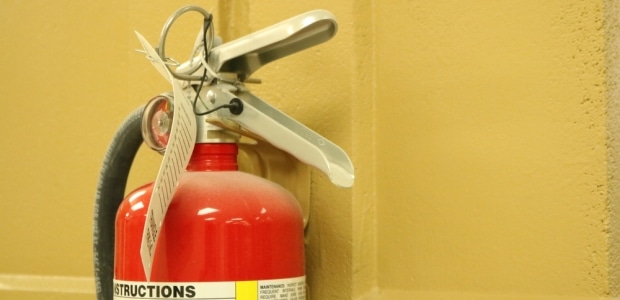 Six Emergency Response Habits Employees Need to Develop
Six Emergency Response Habits Employees Need to Develop
Employees need to refresh their training and have drills regularly so they will be able to rely on both their knowledge and their experience when emergencies happen.
By Karen D. Hamel Jul 01, 2017
If safety glasses, ear plugs, and steel-toed shoes are required in a production area, most employees who work there every day will eventually get into the habit of wearing them—especially when they receive coaching and positive reinforcement for remembering them. When the same start-up procedure is used at the beginning of the shift every day, it will become habitual, too.
Developing good safety habits can help reduce the chance of injuries. But what happens when there is an emergency or something out of the normal happens? Employees need to be just as prepared for the unexpected as they are for routine operations.
Training employees on the types of emergencies that could happen at or around the facility and what their role is during those emergencies are essential first steps in preparing them to respond appropriately. In some cases, the training may be even be required by OSHA regulations. Drills help everyone to apply what they have learned and actually walk through the response process so that it becomes familiar. The trick is having drills often enough that employees can develop emergency response habits.
Many professional responders agree that when there is an emergency, people’s actions don’t rise to the occasion—they fall back to their highest level of training. This happens because it is what they know, which makes them comfortable with the actions they need to take. That’s one of the reasons why even the most seasoned responders train and drill regularly, so that they know what they are going to do, which makes them ready to act instinctively when the need arises.
Given that even professional responders continually train and drill so that they will be prepared to act, it is wrong to assume that employees will instinctively know what to do when there is an emergency. Just like the firefighters, hazmat team, ambulance crew, or anyone else who may be called for assistance, employees need to refresh their training and have drills regularly so that they will be able to rely on both their knowledge and their experience when emergencies happen.
While it is probably not realistic to train every employee to be a contingency planner who is prepared for any time of emergency that could ever happen, each employee needs to specifically know what they are expected to do during different types of emergencies. Here are a few of the basic emergency response habits every employee can develop.
Exit Routes
Some facilities have multiple types of alarms, but for many facilities, an alarm means that something is wrong and everyone should evacuate. Each employee should know where the exit routes are and where the closest exit is. In addition, they should also be able to leave the building at least two different ways.
Be sure that evacuation drills allow employees to practice using both primary and alternative routes so that they are less likely to panic if they aren’t able to use their primary route in an emergency. Employees also should know where to go after they leave the building and whom to report to after they have evacuated.
Chemical Splashes
Under OSHA’s Hazard Communication Standard, hazardous chemical containers need to be properly labeled. The information on the label provides basic information about a chemical’s hazard. But when an employee has been splashed or unsafely exposed to a hazardous chemical, Safety Data Sheets (SDS) can provide more details to better help the affected employee. Knowing where to locate SDS and how to quickly find the one that is needed allows faster response and can lessen the extent of an injury.
Eyewash Stations and Drench Showers
In areas where corrosive chemicals are used, knowing how to get to eyewash stations and drench showers quickly can literally mean the difference between a first aid incident and a recordable injury with a long recovery time. Try blindfolding employees to see whether they can reach the nearest eyewash or drench shower in less than 10 seconds.
Fire Extinguishers
Most building codes require fire extinguishers; because they need to be checked monthly, most are fully charged and ready to use. However, whether or not employees should actually use them is sometimes a debate. Some facilities develop “do not use” policies because they feel that having an employee attempt to put out an incipient fire with an extinguisher is too big of a risk. Instead, they want their employees to pull the fire alarm and exit the building.
For facilities that do not have this type of policy, annual fire extinguisher drills can help them to remember to pull, aim, squeeze, and sweep. Be sure that these drills also include instruction on exiting the building if they have exhausted an extinguisher but have failed to put out the fire.
Spill Response
Most spills that happen in fixed facilities are small and can be safely cleaned up by employees in the immediate area. OSHA calls these “incidental spills.” When a spill creates an unsafe atmosphere or threatens the health of employees, it is most likely an “emergency spill” and needs to be cleaned up by employees who have been trained to OSHA’s Hazardous Waste Operations and Emergency Response (HAZWOPER) Standard.
All employees need to be taught how to quickly determine whether they are capable of cleaning up a spill or need to call in trained emergency spill responders. Volume, location, chemical properties, and levels of training are all factors that need to be taken into consideration when training employees how to determine whether a spill is incidental.
Injury Response and Reporting
Facilities that are not located in close proximity to hospitals or infirmaries need to have employees who are trained to administer first aid. While it is not necessary for every employee to receive first aid training, it is important for every employee to know what to do when someone is injured. At a minimum, every employee should know whom to report an injury to, as well as the process that will be used to investigate the root cause of an incident. Even elementary skills such as being able to retrieve the first aid kit or AED, or being able to meet the ambulance at the door and direct them to an injured employee, are helpful.
Few people ever reach the point where responding to emergencies is as instinctive as tying their shoes. But without regular emergency training and drills, response actions will never become familiar, let alone become habits. The more comfortable employees are with their roles in emergency response, the more likely they will be to follow established plans and avoid injuries.
This article originally appeared in the July 2017 issue of Occupational Health & Safety.
Emergency Response is a Matter of Time
Written and published by: Ryan Pfund, Occupational Health & Safety Magazine
January 1, 2017
In an emergency, the faster the response, the better the outcome.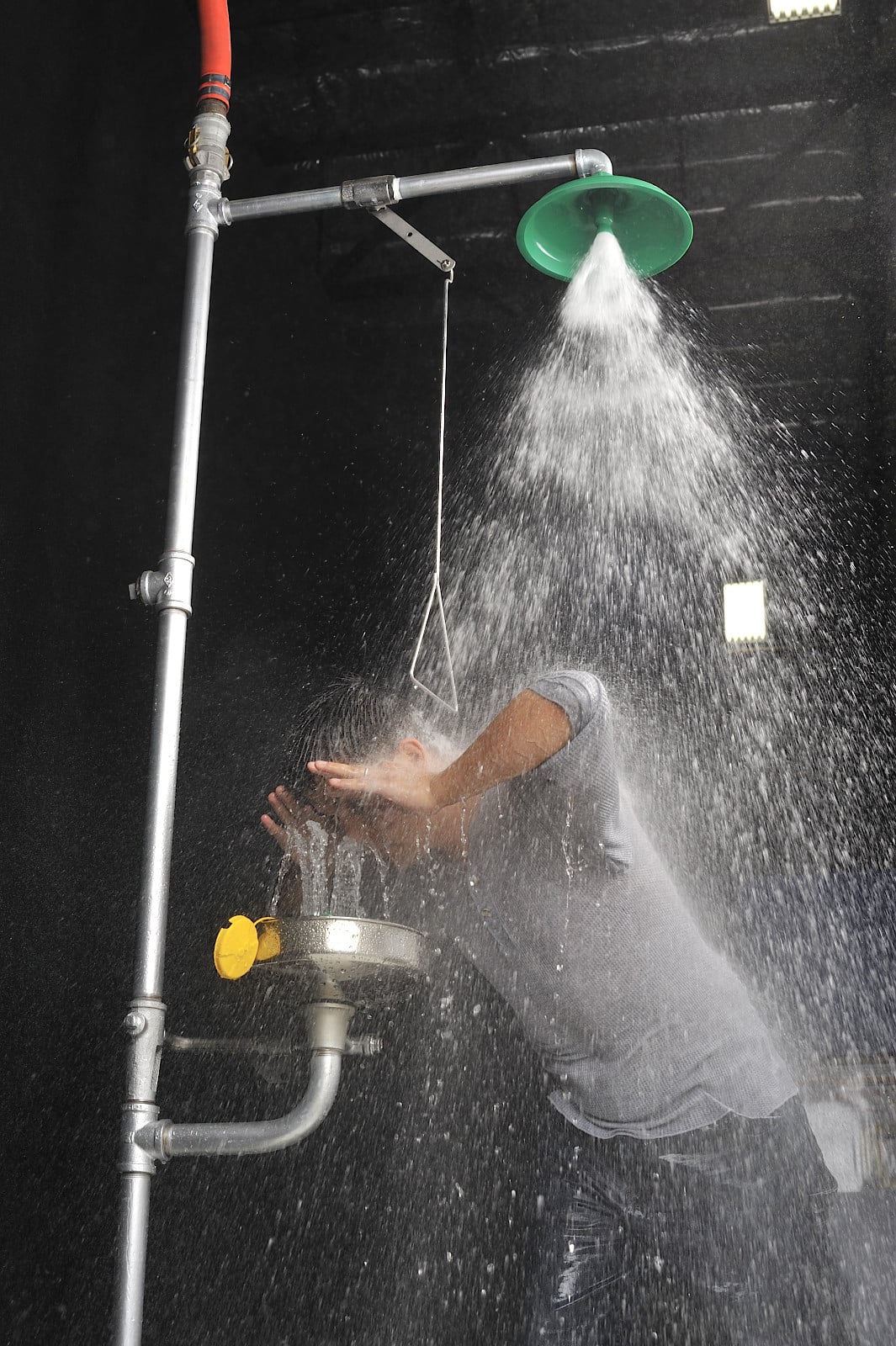
An emergency safety plan that anticipates every work site emergency and improves emergency response time is every facility manager’s and employee’s best protection. It’s difficult to think clearly and logically in a crisis, so having a well-orchestrated strategy in place that can be properly and quickly executed by employees makes all the difference.
When an employee at a work site is exposed to hazardous chemicals, taking these pre-emptive actions will help ensure the most positive outcome:
1) Providing a well-organized work site equipped with easily accessible eyewashes or drench showers
2) Minimizing the length of response time for accessing emergency equipment and drenching the employee’s affected area(s)
3) Employing emergency signaling systems to ensure immediate help is on the way, including emergency medical care
Time is clearly of the essence in stopping the exposure, alleviating discomfort and pain, and preventing further or permanent facial and bodily damage. For example, an eyewash or drench shower must be located within 10 seconds of the hazard, so the injured person can quickly and easily reach the plumbed fixture to immediately drench affected areas. Time is also a factor in the length of time one stays in the flushing fluid, which should be for a full 15 minutes as required by the ANSI/ISEA Z358.1 standard. Reaction time of emergency response personnel to swiftly gain access to the injured party is also critical in halting further injury and getting the exposed user proper medical attention.
For proper and expedient execution of a safety plan, it’s important to carefully review with employees the basics on placing and using emergency safety equipment and what to do following a co-worker’s accident. Consider these elements of emergency planning and response preparedness:
Why Use Emergency Fixtures?
Emergency safety showers and eyewashes prevent permanent eye and skin damage from chemical burns or foreign substances generated by grinding, hammering, chipping, testing, pouring, storing, transporting, and disposing operations. Proper selection, placement, and maintenance of this equipment will minimize risk of exposure while reducing the chances of catastrophic employee health impacts, work productivity, or even legal costs for the facility.
Eyewash and drench shower fixtures are placed throughout hazardous environments wherever there is risk of exposure to eye or bodily contaminants. Environments also may include inclement conditions such as heat, freezing, and airborne chemicals. Plumbed, portable, and self contained/stand-alone units should be matched to work site needs.
Where Are Proper Locations for Placement?
Each unit should be stationed close to a hazard, easily seen, and in immediate good working order. It is highly recommended to conduct a walk-through of the facility with a health or safety expert to determine proper locations and types of fixtures for each location.
Here are some fundamental placement guidelines:
- Emergency shower fixtures must be within 55 feet of a potential hazard and must take no more
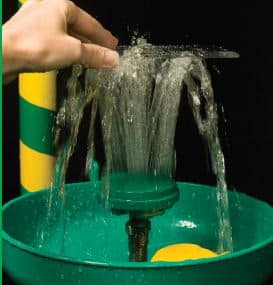 than 10 seconds to access. In addition, the path to the fixture must not be obstructed by debris or other hazards that could interfere with the fixture’s use.
than 10 seconds to access. In addition, the path to the fixture must not be obstructed by debris or other hazards that could interfere with the fixture’s use. - The area around the fixture should be well lit to optimize visibility, and each fixture should be identified with a highly visible sign.
- If a potential chemical spill in an area is likely to affect multiple workers, a sufficient number of fixtures should be made available.
- If the worker’s ability to walk or move could be impacted by the chemical exposure, the fixture should be placed closer to the worker.
- The equipment must be on the same level on which the user is working.
When Is an Eyewash Needed vs. a Drench Shower?
After potential hazards throughout a work site are identified, consider how the types of fixtures can best address the risk:
- Emergency eyewash stations
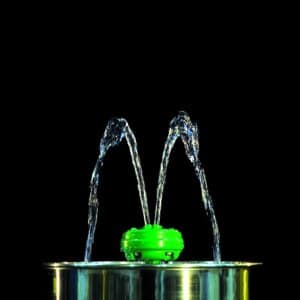
- effective for spills, splashes, dust, or debris likely to affect only the eyes
- provides a controlled flow of water to both eyes simultaneously
- delivers an uninterrupted, 15-minute supply of tepid water; plumbed units can supply a greater volume of water available to the user—between 7.5 and 19.0 liters (2.0 and 5.0 gallons) per minute
- Emergency eye/face wash stations

- used when the entire face is at risk from spills, splashes, dust, and debris
- irrigates the eyes and face simultaneously
- provides a large distribution pattern of water (minimum 11.4 lpm/3.0 gpm) to effectively rinse the entire face
- Drench showers
- used when larger areas of the body are at risk
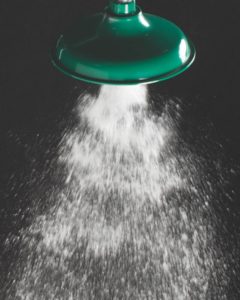
- flushes a larger portion of the body but is not appropriate for the eyes (a combination eyewash and drench shower may be used to simultaneously flush the eyes and rinse larger areas of the body)
- used when larger areas of the body are at risk
Drench showers work by simply pulling down on the drench shower handle while standing directly underneath the shower head. New technology will effectively drench the entire body without needing to move around in the spray pattern. Eye and eye/face washes work by pushing a handle or lifting a bowl cover. The face is then positioned directly in the flushing fluid, while the user holds their eyelids open with their fingers. The user should roll his or her eyes around while positioned directly in the eyewash streams to effectively rinse the entire eye. Ensuring employees are trained on the proper and expeditious use of equipment is essential to worker safety.
For both eyewashes and drench showers, it’s essential to have direct and on-demand access to tepid water—per ANSI requirements—to encourage a full and effective flush of the affected area. ANSI Z358.1-2014 stipulates that an injured worker remains beneath the drench shower and/or flush his eyes/face for a minimum of 15 minutes to increase the likelihood of a complete and successful treatment and minimize the possibility of inadvertently spreading hazardous material to other areas.
What Is the Response Protocol After Someone Uses an Emergency Fixture?
Each employee should be trained on what action to take in assisting the affected employee(s) and how to report emergencies to emergency medical personnel. To help with the notification process, it is essential to have the ability to immediately send a clearly recognizable signal of an emergency that notifies others to help and/or send help. Using new signaling technology that works in tandem with each emergency fixture will quickly notify on-site workers and medical personnel and expedite the emergency response and recovery process.
Using a signaling system along with emergency fixtures is important because of common hindrances in the work site to alerting others. For example, industrial work environments don’t always allow for several people to be in the immediate area of a work site hazard. One person could be working outside alone or only a few people could be working within an expansive area or during third shift. These situations can affect co-workers’ capacities to be aware that an emergency is even happening and, therefore, impede their abilities to help the injured get follow-up medical care.
Another obstacle in providing immediate emergency response and post-medical care is the time it takes for emergency responders to be dispatched to a work site. According to NEDARC (the National EMSC Data Analysis Resource Center), the average emergency medical services response time in the United States is 9.4 minutes. The sooner EMS teams are alerted, the sooner they can attend to a work site emergency.
While all employees should be trained on what to do if a co-worker has been exposed to hazardous chemicals, they should not be relied upon to completely abate the emergency. It’s best to ensure proper medical response is provided in such a dynamic and emergent situation, and an emergency signaling system is a clear method to communicate when and where medical assistance is needed.
How Do Emergency Signaling Systems Work?
Signaling devices are connected to emergency showers and eyewashes. Upon activation of the fixtures, the signaling devices are automatically triggered to turn on a highly visible flashing light and a loud sound designed to cut through ambient noise. The signaling systems call others to help, draw attention to the precise location of need, alert management to contact first responders, and provide remote monitoring of safety equipment.
Installing an emergency signaling system is a much faster and efficient way to alert those in the immediate area, as well as managers or safety personnel in other locations, that an employee is in need of help. It’s important to make sure various alarms in the facility are highly distinctive and recognized by all employees as a signal to response actions identified in your plan.
The first seconds following eye and skin exposure are absolutely critical to minimizing worker injury, which is always the main goal of any worker safety program. Instituting a well-devised safety plan, having access to proper emergency equipment, and providing a reliable emergency signaling system can expedite response and improve the outcome of the emergency.
Things to Consider When Choosing Emergency Showers and EyewashesBy Jim Schneider, Plumbing Engineer Magazine
In many work environments, properly installed and utilized emergency fixtures can mean the difference between a minor injury and a major injury or worse. When health and safety is on the line, it’s important to make sure all necessary considerations are taken into account when facilities are being designed and built.
Plumbing Engineer recently spoke to Margo Mee, Product Manager at Haws Corp., about things to think about when choosing emergency fixtures and systems.
PE: Can you tell us about Haws’ background with emergency fixtures?
MM: Haws invents, manufactures and builds drinking fountains and standardized and customized emergency response products. For all our products, we continually focus on quality, service, reliability and complete solution support just as we have done for more than 100 years.
PE: What are some of the primary considerations when selecting emergency fixtures?
MM: When researching and purchasing a unit, a product that mimics medical protocols, offers full ANSI compliance in all scenarios, and really considers victim needs and comfort is the ideal solution to offer a complete emergency response system.
PE: From the manufacturing side, what are some of your primary considerations when designing and making emergency fixtures?
MM: Victim comfort for maximum results is the primary consideration when designing emergency products, but it also important that the product is reliable and durable. Our quality products are thoroughly tested and evaluated at numerous points during design and build.
PE: What kinds of challenges do you face with emergency fixtures? How do you deal with those challenges?
MM: Because they are not used frequently, a lot of facilities will place their importance on the back burner and not evaluate if their site’s needs have changed, if the install location is still ideal, if the units even work or are ANSI compliant. The best way to address these common issues is through continuous education. We offer onsite facility testing and evaluation, detailed informational videos, and on-demand and live webinars with access to our engineering team.
PE: Has the standard and market for emergency fixtures remained pretty constant, or are there many updates and changes?
MM: The last major change in the standard was in 2009. That revision included a definition for tempered water and from there you could see product changes. The market itself continues to grow as people are more educated and are asking the right questions and demand that their site provide the ideal solution. Manufacturers are held accountable for providing a reliable product and if they can’t adhere, their products are being replaced.
PE: Are there any trends or updates to the standard you see on the horizon?
MM: We would hope to see a revision in the next 6-12 months.
PE: You wrote a white paper about exceeding the ANSI Z358.1 Standard. Can you tell us a little about the baseline of the standard itself?
MM: The ANSI Z358.1 Standard defines emergency eyewash and shower design, location, testing, activation, and temperature requirements for proper functionality and usage. Simply providing emergency eyewash and shower products is not enough. Facilities must inspect, test, and monitor emergency equipment system readiness and performance. Even though the most current ANSI Z358.1 standard now dates to 2009, most emergency eyewash and shower units across North America still do not yet comply with these significant provisions.
PE: Why should end users be looking to exceed the standard?
MM: Treat the situation as if you could be a victim. You would only want the best solution that performs as required as well as provides an additional benefits so the emergency response tool doesn’t cause further injury.
PE: How can products and systems exceed that standard?
MM: Haws products go beyond the minimum performances of emergency eyewashes and showers requirements by keeping the victim in mind when in an emergency situation. Haws products include victim comfort with water pressure and flow, effective flushing with the use of our unique AXION directional flow, appropriate and recognizable color coding, and temperature controls to encourage proper usage. In addition, Haws offers a variety of educational tools to help educate and train users.



